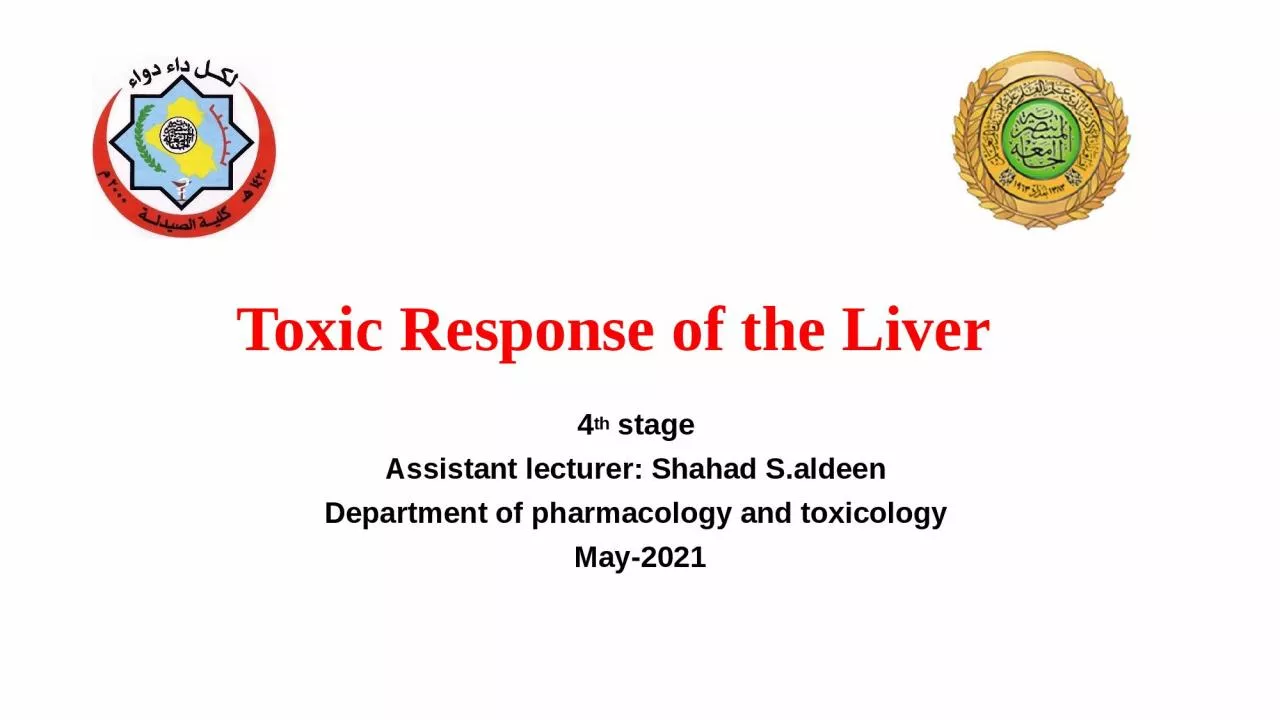

4 th stage Assistant lecturer Shahad Saldeen Department of pharmacology and toxicology May2021 Headline Introduction Types of liver injury Steatosis Necrosis Apoptsis Fibrosis ID: 927460
Download Presentation The PPT/PDF document "Toxic Response of the Liver" is the property of its rightful owner. Permission is granted to download and print the materials on this web site for personal, non-commercial use only, and to display it on your personal computer provided you do not modify the materials and that you retain all copyright notices contained in the materials. By downloading content from our website, you accept the terms of this agreement.
Slide1
Toxic Response of the Liver
4th stage Assistant lecturer: Shahad S.aldeen Department of pharmacology and toxicology May-2021
Slide2Headline
Introduction Types of liver injury SteatosisNecrosisApoptsis Fibrosis
CirrhosisCholestasis Hepatitis CarcinogenesisDrugs-induced liver injury
Signes
and symptoms of hepatotoxicity
Treatment
Slide3Introduction
The liver is the main organ where chemicals are metabolized and excreted. so, the liver cells are exposed to these chemicals which can results in liver dysfunction, cell injury and liver failure.
Slide4Types of the liver injury
The liver injury caused by chemicals (hepatotoxicity) is not a single entity, thus the lesion observed does not depend only on the chemical agent involved, but also on the nature of exposure (acute or chronic, reversible or irreversible), mechanism of toxicity, number & type of the cells affected & localization within liver (periportal, or centrilobular zones).
Slide5Cont.…
So that, liver injuries divided into the following major types:Steatosis (fatty liver) NecrosisApoptosis
Fibrosis CirrhosisCholestasis
Hepatitis
Carcinogenesis
Slide6Steatosis (fatty liver):
Is accumulation of abnormal amount of lipids (mainly triglycerides) as vacuoles & droplets within hepatocytes; as a result of imbalance between rate of synthesis & release of these lipids by liver cells into circulation.
In general, chemicals-induced steatosis is often reversible & doesn't necessary lead to hepatocytes death and it is an acute response to many but not all hepatotoxicants.
Slide7Slide8Necrosis (cell death):
Is an acute response of liver injury associated with cell swelling, leakage of nuclear material and influx of inflammatory cells as a result of plasma membrane damage, alteration in calcium homeostasis, lipid peroxidation, disruption to cytoskeleton and damage to cell organelles
Slide9Liver necrosis
Slide10Necrosis with steatosis
Slide11Apoptosis (cell death):
Characterized by cell shrinkage, nuclear fragmentation, formation of apoptotic bodies, & lack of inflammation.
Apoptosis is more difficult to be detected histologically because of the rapid removal of affected cells.
Slide12Fibrosis
Fibrotic tissue
Chronic type of liver injury, usually results from long-term & multiple exposures to a toxic chemicals that cause destruction to the hepatic cells with replacement by collagen fibers.
With continuing collagen deposition, the architecture of the liver is disrupted by interconnecting fibrous scars.
Slide13Cirrhosis
Cirrhosis is an irreversible damage result mainly from alcohol induced fatty liver & has a poor prognosis of survival.
Slide14Slide15Cholestasis (the flow of bile from your liver is reduced or blocked
)Characterized by
reduction or block in bile flow leads to increase level of particularly bile acids & bilirubin in the blood due to either hepatic disorders (Canalicular) or biliary duct damage (cholangiodestructive).
Cholestasis could be acute or chronic response, & it’s result from many different types of chemicals that cause cholestasis
.
Slide16Hepatitis (inflammation of liver)
It is caused by many factors including drugs, toxins, bacteria & viruses. It is characterized by emigration of neutrophils, lymphocytes & other inflammatory cells into region of damaged hepatocytes. Immunoresponse
of liver cells to some types of chemical agents can result after their biotransformation, binding with liver proteins & leak out of injured hepatocytes serve as an antigen that stimulate the production of antibodies. Hepatitis could be an acute or chronic type.
Slide17Viral hepatitis
Slide18Carcinogenesis
Tumor of hepatic tissue caused by chemicals that undergo metabolic conversion to more toxic intermediates. They exert their carcinogenicity by interaction with nuclear materials, mainly the DNA, results in alterations in the genetic machinery causing mutations & initiation of a chain of events that result in cancer formation. It’s a chronic type of liver injury
Slide19Liver cancer
Slide20Drugs induced liver injury
Slide21Signes and symptoms of hepatotoxcity
Yellowing of the skin and white of eyes (jauindice)
FatigueLoss of appetite Nausea and vomiting
Weight loss
Dark or tea-colored urine
Slide22Treatment
Stop exposure to the toxicant Activated charcoal should be given within 30 min. why ? Supportive treatment : IV fluid and medication to relieve nausea and vomitingN-acetylcysteine should be given (in case of acetaminophen toxicity ) within 8hr loading dose 140 mg /kg followed by 70mg /kg each 4
hrs Liver transplant in case of sever cases
Slide23This Photo
by Unknown Author is licensed under CC BY